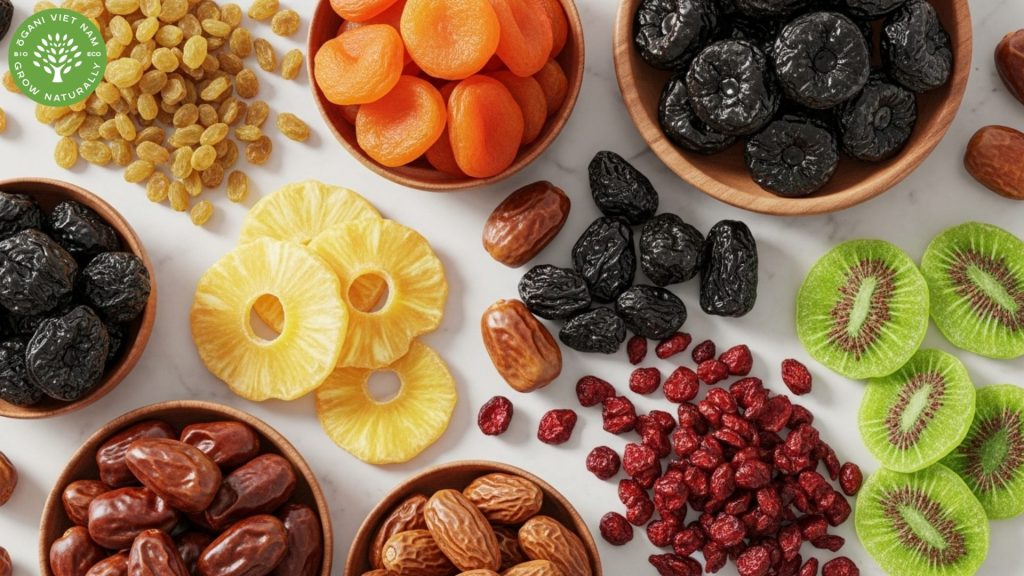
Dried fruit is an easy and healthy way to enjoy nature’s sweetness any time of the year. Packed with vitamins, minerals, and fiber, it makes a perfect snack or a tasty addition to your favorite recipes.
At Ogani VN, we know that the right dried fruit can make your snacks more enjoyable and your cooking more exciting. Here’s everything you need to know about these little nutrition powerhouses.
Types of dried fruit and their unique benefits
The world of dried fruit is full of variety, with each type offering its own unique taste and nutritional benefits.
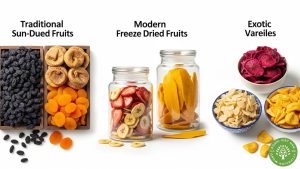
Traditional sun-dried varieties
Sun-dried fruits like raisins, apricots, and figs are among the oldest ways to preserve fruit. California sun-dried raisins remain a favorite, offering natural sweetness and a long shelf life. Dried apricots are packed with beta-carotene and iron, while keeping that tangy-sweet flavor that works perfectly for snacking or baking.
Turkish figs and Medjool dates stand out as premium choices. They bring rich flavors and excellent nutritional value. Many of our customers love using dates as a natural alternative to sugar – once you try a soft, ripe Medjool date, regular candy just doesn’t compare.
Modern freeze-dried options
Freeze-dried fruits have become very popular, and it’s easy to see why. This method keeps more of the fruit’s original shape and nutrients than traditional drying. Freeze-dried strawberries, bananas, and mangoes stay crisp and crunchy, offering a texture many people prefer over chewy dried fruit.
The freeze-drying process removes moisture while preserving most of the vitamins. Still, recent recalls show why it’s important to buy from trusted suppliers.
Exotic and specialty varieties
Don’t miss out on some of today’s more unique options. Dried jackfruit, crystallized ginger, and dried dragon fruit are becoming easier to find. These specialty fruits bring exciting flavors to trail mixes or make fun conversation starters at any gathering.
Health benefits and nutritional value
Dried fruit packs many of the good things found in fresh fruit, though drying does bring some changes worth knowing.
Fiber stands out among its benefits. A small serving of prunes, for example, provides plenty of dietary fiber to support digestion. Dried cranberries contain proanthocyanidins, which may help urinary tract health, while dried blueberries keep much of their antioxidant content.
But there’s one thing to keep in mind: sugar concentration. Removing water naturally increases sugar levels, so dried fruits are higher in calories per gram than fresh fruit. That doesn’t make them bad – it just means watching portion sizes is important.
The key is to enjoy dried fruit as a concentrated source of nutrition, not as an all-you-can-eat snack.
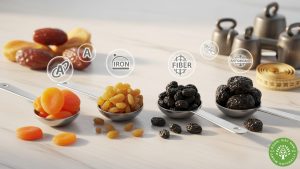
Most dried fruits keep plenty of potassium, iron, and B vitamins. Dried apricots are especially high in vitamin A, while raisins offer a good source of iron. Many dried fruits also retain strong antioxidant levels, including phenolics and flavonoids.
What often surprises people is how versatile dried fruits can be. They’re great for athletes needing quick energy, for those on plant-based diets looking for iron, or for anyone wanting to cut back on refined sugar by using dates or raisins as natural sweeteners.
How to choose high-quality dried fruit
Choosing quality dried fruit takes a bit more care than you might think, especially with so many options available today.
Reading labels and avoiding additives
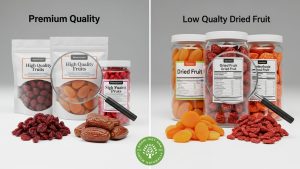
Always read the ingredient list carefully. The best dried fruits usually contain just the fruit itself, sometimes with a bit of oil to prevent sticking. Try to avoid added sugars, sulfur dioxide (unless you prefer sulfured varieties), or artificial preservatives.
Organic certification can be a sign of higher quality, but it’s not the only thing to look for. Many small producers make excellent dried fruits without certification, while some large organic brands focus more on appearance than nutrition.
Understanding processing methods
Sun-dried fruits tend to be darker and chewier. They might lose a bit of vitamin C compared to freeze-dried fruits, but their flavors are usually more concentrated. Freeze-dried fruits, by contrast, keep their original look and offer a light, crunchy texture.
Some fruits, like apricots and pineapple, are treated with sulfur dioxide to keep their colors bright. While generally safe, some people prefer to skip sulfured fruits for personal or health reasons.
Evaluating appearance and texture
Quality dried fruit should still look like the fruit it came from — not an unrecognizable, shriveled lump. Good raisins will plump up when soaked in warm water. Premium dried mango should be slightly flexible, not rock-hard. Steer clear of anything that looks overly oily, has white spots (a possible sign of mold), or smells off.
Proper storage and safety considerations
Storing dried fruit properly helps it last longer and keeps its flavor and nutrients intact.
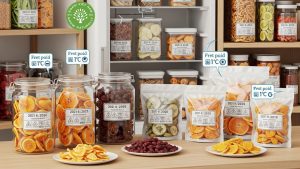
Optimal storage conditions
Most dried fruits store best in a cool, dry place away from direct sunlight. Airtight containers help prevent moisture buildup and keep pests out. Glass jars are great, but sturdy plastic containers work well too.
An unopened package usually does fine in the pantry. Once opened, keeping it in the fridge can extend freshness, especially for preservative-free products. If you buy in bulk, freezing portions is a smart way to make them last even longer.
Recognizing spoilage signs
Even with proper storage, dried fruit won’t last forever. Watch out for unusual smells, visible mold, extreme hardness, or any sign of pests. If it starts to smell alcoholic, that means fermentation has begun and it’s time to throw it out.
Recent recalls over listeria contamination are a reminder to buy from trusted sources and stay updated on food safety alerts. While dried fruit is generally safe thanks to its low moisture content, contamination can still happen during processing or packaging.
Shelf life expectations
When stored properly, dried fruits usually keep their quality for 6–12 months, though it depends on the type and how they’re processed. Dates and figs often last longer than delicate fruits like dried berries. Vacuum-sealed packs generally stay fresh longer than dried fruit bought from bulk bins.
Frequently Asked Questions
Is dried fruit as healthy as fresh fruit?
Yes, but with differences. Dried fruit keeps most of the minerals and fiber from fresh fruit but has more concentrated sugars and less vitamin C. It’s still nutritious — just enjoy it in smaller portions than fresh fruit.
How much dried fruit should I eat daily?
About ¼ cup (roughly 30 g) is a typical serving. That’s enough to give you good nutrition without too much sugar.
Can diabetics eat dried fruit?
Yes, in moderation. Choose unsweetened varieties, keep portions small, and monitor blood sugar. It’s best to check with a healthcare provider for personal advice.
Why are some dried fruits so expensive?
Prices reflect factors like processing methods, quality of the fresh fruit, organic certification, and specialty varieties. Premium dried fruits often taste better and offer higher nutritional value.
What’s the difference between dehydrated and freeze-dried fruit?
Dehydrated fruit uses heat to remove moisture, resulting in a chewy texture. Freeze-drying removes moisture through sublimation, which helps preserve the fruit’s shape and nutrients.
Start your dried fruit journey with confidence
Dried fruit is nature’s way of giving you sweetness, energy, and nutrition — all in one bite. From timeless favorites like raisins and dates to crunchy freeze-dried mango or strawberries, these little powerhouses can turn a quick snack into something special and take your recipes to the next level.
At Ogani VN, we don’t just sell dried fruit — we handpick it. Every batch comes from trusted growers who care about quality, safety, and flavor as much as we do. Whether you’re looking for organic treats, bulk packs for your baking days, or a beautiful gift box, we’ve got something that’s just right for you.
So, why settle for ordinary snacks? Step into our world of premium dried fruit and taste the difference. Your body will love the nutrition, your taste buds will love the flavor — and you’ll never look at snacking the same way again.
Read more:
- Red Dragon Fruit Benefits: The Ultimate Guide to This Antioxidant Powerhouse
- Dried Pineapple No Sugar Added: Healthy Snack by Ogani VN
- Dragon Fruit Powder: Unlocking Ít Superfood Potential for Health and Wellness.
- Dried Mango Benefits: 7 Amazing Health Reasons To Include This Superfruit In Your Diet
- The Complete Guide To Dried Fruit: Benefits, Types & Storage Tips

